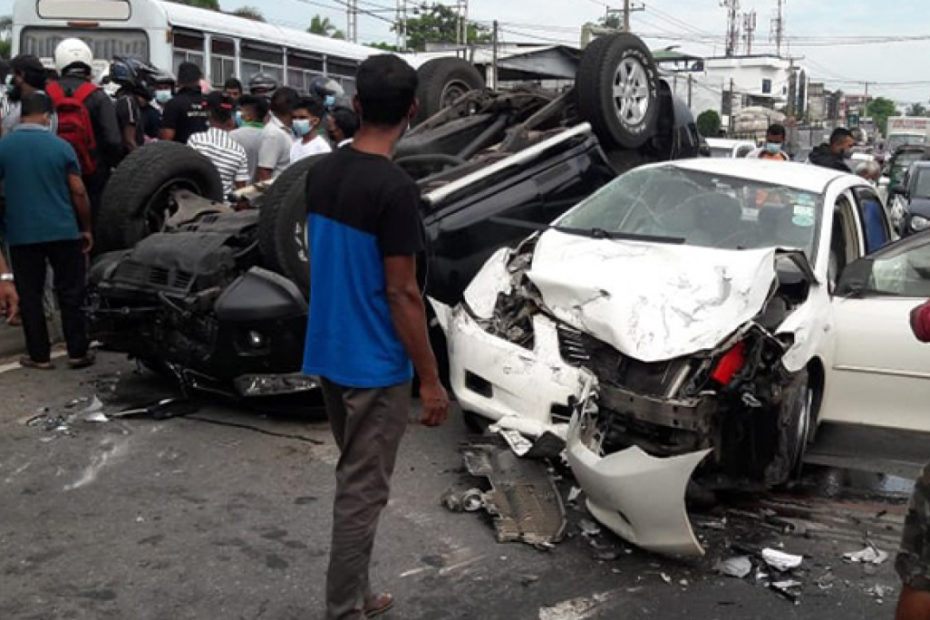Road crash deaths per capita in Sri Lanka are the highest among its immediate neighbors in South Asia, according to the World Bank article.
HIGHLIGHTS
- Data shows every year 38,000 crashes cause 3,000 deaths and 8,000 injuries
- Road crash fatalities and injuries could cost countries like Sri Lanka between 3-5% of their GDP annually
- $2 billion additional investment needed to combat road safety crisis
Priyantha Fernando* (34) was heading home after a typical day’s work when his motorcycle crashed into a lorry. His wife and two children saw their lives changed instantly when they lost the family’s sole breadwinner. Unfortunately, this tragic and unnecessary loss of life is all too common in Sri Lanka.
Available data shows an average of 38,000 crashes annually in Sri Lanka resulting in around 3,000 deaths and 8,000 serious injuries. The estimated annual road crash deaths per capita are the highest among its immediate neighbors in South Asia and five times that of the best-performing countries in the world.
High road crash fatality and injury rates on Sri Lanka’s roads are undermining the economic growth and progress made over the past decade on reducing poverty and boosting prosperity. Over two-thirds of road crash victims are productive, working-age adults between 15-64 years of age.
Vehicle UIO growth too a factor
This situation is exacerbated by the rapid growth in vehicle ownership – 67% between 2011 and 2018 – and the diversity of motorized and non-motorized traffic of varying sizes and speeds. This leaves vulnerable road users without adequate protection – more than 90% of crash victims are pedestrians, cyclists, and motorcyclists.
If this trend continues, as expected, crash fatalities and injuries will steadily climb— unless urgently required measures are implemented.
This is an issue vital to the country’s health, well-being, human capital, and economic growth. The World Bank estimates that road crash fatalities and injuries could cost countries like Sri Lanka between 3-5% of GDP annually. The cost of inaction is too high.
“It is estimated that Sri Lanka will require an additional investment of almost $2 billion over the coming decade if it is to achieve the Sustainable Development Goal 3.6 target of a 50 percent reduction in national road crash fatalities.”

More than 90% of crash victims in Sri Lanka are pedestrians, cyclists, and motorcyclists.
Poor road safety performance in Sri Lanka is a symptom of underinvestment in targeted initiatives. It is estimated that Sri Lanka will require an additional investment of almost $2 billion over the coming decade if it is to achieve the Sustainable Development Goal 3.6 target of a 50 percent reduction in national road crash fatalities.
It will take a long-term commitment and sustained vision from the Government of Sri Lanka for this investment to be effective and improve road safety performance on a sustainable basis.
The Solution
Initiatives must be systematic and at scale, with institutional capacity being strengthened, to ensure successful delivery:
- Strengthening safe infrastructure design to ensure the protection of all road users and inclusion of roadside communities.
- Establishing robust vehicle and driver licensing systems that are accessible by law enforcement agencies and regulatory authorities before the full power of safety compliance regimes can be exercised.
- Facilitating inclusive road user policies and integrated land use/transport planning to ensure urban and rural roads are safe and accessible for all road users.
- Prioritizing speed management in all planning and policy considerations addressing infrastructure, vehicle, and road user safety issues.
Agencies responsible for road safety need to be adequately empowered and resourced to deal with escalating dangers on the roads. This includes addressing governance challenges and gaps in road crash data.
These issues undermine the capacity to develop a results-focused strategy and ensure its adequate coordination and implementation. More effective, efficient, and scaled-up initiatives are required to define good road safety practices and provide a blueprint for action.
Targeted road safety investments will contribute to the accumulation of human capital in Sri Lanka, which in turn will contribute to sustainable and inclusive economic growth and overall country wealth. It will also contribute to other sustainable mobility goals including improved transport productivity, universal accessibility, climate change mitigation and adaptation, and reduced local air and noise pollution.
Positive signs of government action are emerging with the proposed establishment of the National Road Safety Commission. Efforts are also underway to establish a national road crash database. These proposed actions will pave the way for sustained road safety and people-centric development in Sri Lanka.
Our Take
Ture that all these measures are needed in the long term. But, there are simple, rather basic measures the country can execute in little or no time to combat the matter.
Immediate
- Stop curb parking. This leads all other road users to manure unexpectadly leading to collitions.
- Strict lane decipline regulations, including the use of left lane unless for overtaking.
- Establish a maximum speed of 30 within urban areas and 50 non urban for all commercial vehicles.
Short term
- Phase out tuk tuks. Ban driving a tuk by an aged less than 40, for hiring purposes.
- Establish guidance for scintific training and Mid carrier driver training: https://mobility.lk/2021/03/21/driver-training/
- Establish bicycle lanes to take at least 10% daily capital city visitors with an expenditure of LKR 200M, saving LKR 600M a year. https://mobility.lk/2020/05/01/cycle-paths-to-enter-colombo/
Mid term
Developing Defensive Driver (DDD) culture and attitude: https://mobility.lk/2021/03/21/defensive-driving/
Link for original article https://www.worldbank.org/en/news/feature/2021/11/04/sri-lanka-s-journey-to-road-safety *Names changed to protect privacy
